University Business Valuation and Analysis Homework Solution 2017
VerifiedAdded on 2020/05/16
|8
|1068
|256
Homework Assignment
AI Summary
This homework assignment covers key concepts in business valuation and accounting. It begins by differentiating between cash and accrual basis accounting, explaining how transactions are recorded in each method and highlighting the advantages and disadvantages of each. The assignment then focuses on adjusting entries, detailing their importance in ensuring the accuracy of financial statements and providing examples of common types such as accrued income and prepaid expenses. The solution includes examples of journal entries. The assignment also addresses the distinction between depreciation and accumulated depreciation, explaining how depreciation is calculated using the straight-line method and its impact on the balance sheet. Finally, it discusses the book value of an asset and its relationship to depreciation.
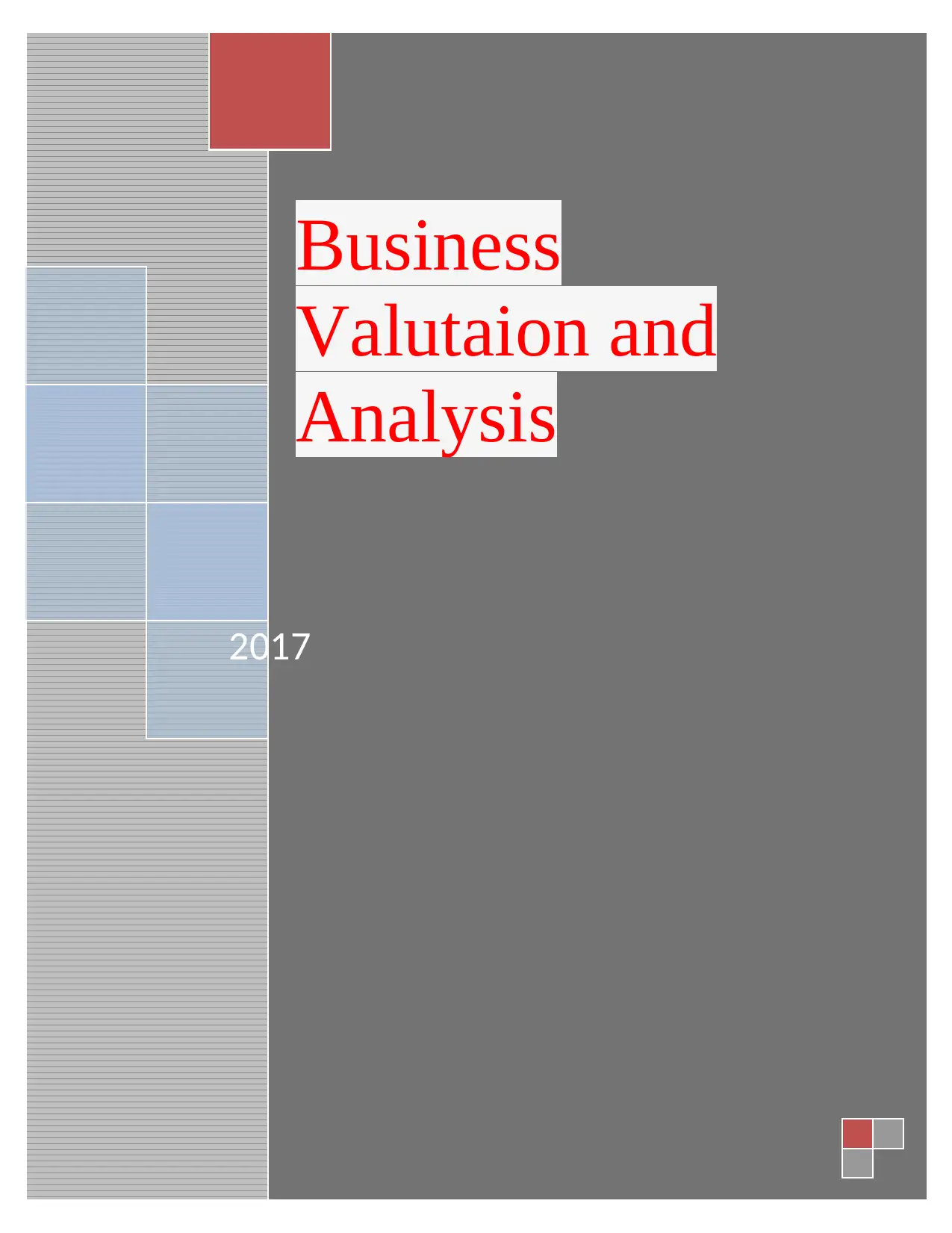
2017
Business
Valutaion and
Analysis
Business
Valutaion and
Analysis
Paraphrase This Document
Need a fresh take? Get an instant paraphrase of this document with our AI Paraphraser
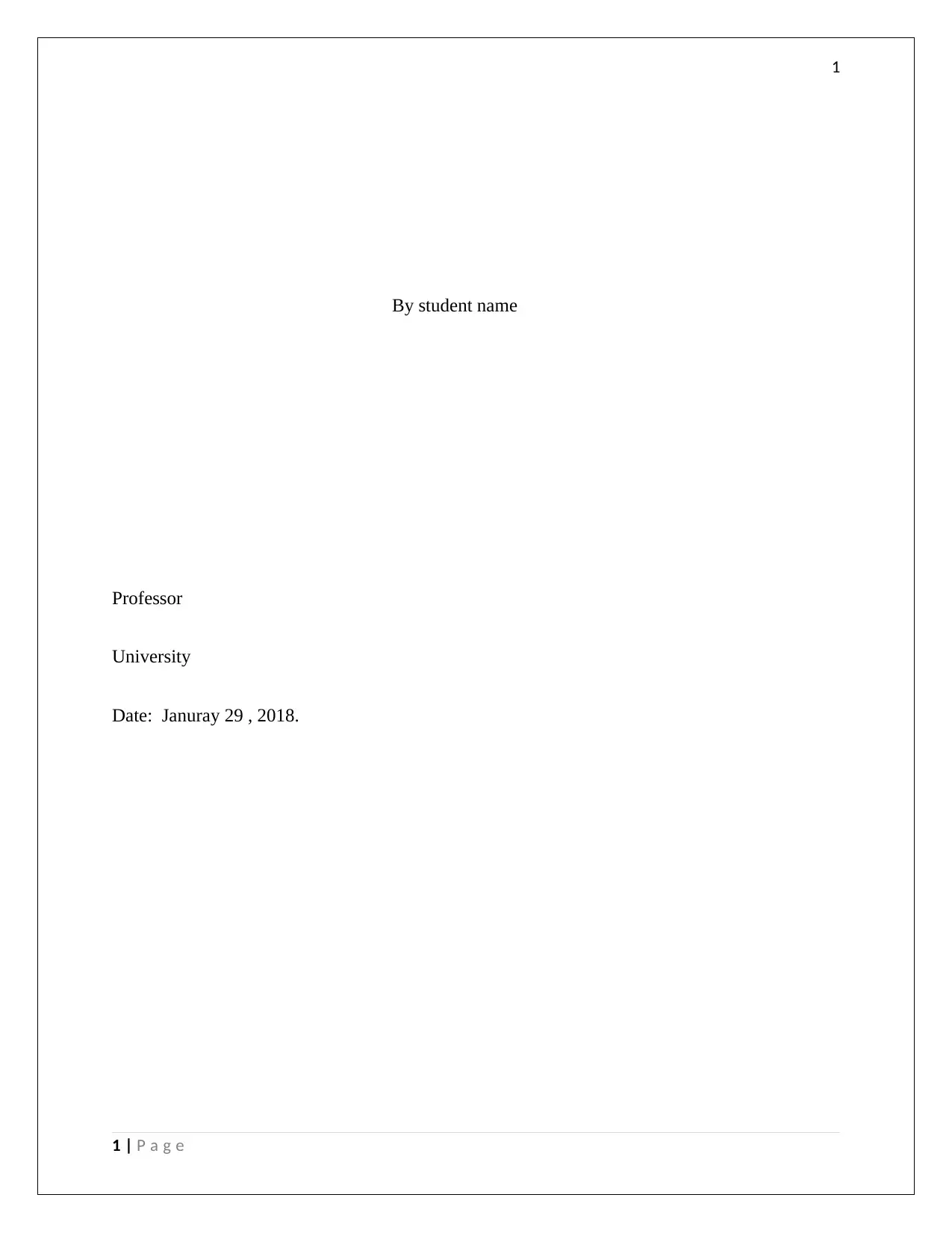
1
By student name
Professor
University
Date: Januray 29 , 2018.
1 | P a g e
By student name
Professor
University
Date: Januray 29 , 2018.
1 | P a g e
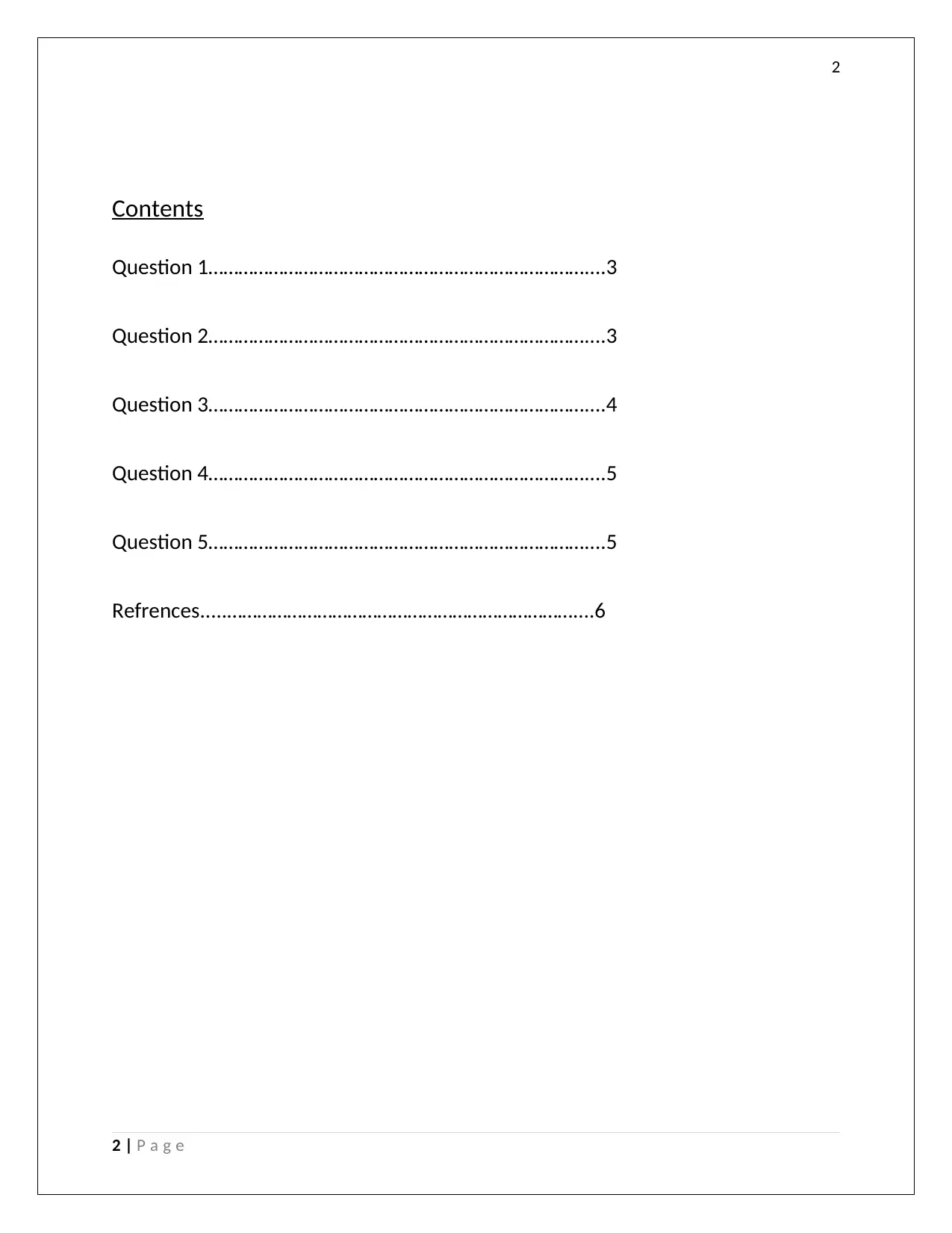
2
Contents
Question 1…………………………………………………………………....3
Question 2…………………………………………………………………....3
Question 3…………………………………………………………………....4
Question 4…………………………………………………………………....5
Question 5…………………………………………………………………....5
Refrences.....……………………………………………………………....6
2 | P a g e
Contents
Question 1…………………………………………………………………....3
Question 2…………………………………………………………………....3
Question 3…………………………………………………………………....4
Question 4…………………………………………………………………....5
Question 5…………………………………………………………………....5
Refrences.....……………………………………………………………....6
2 | P a g e
⊘ This is a preview!⊘
Do you want full access?
Subscribe today to unlock all pages.

Trusted by 1+ million students worldwide
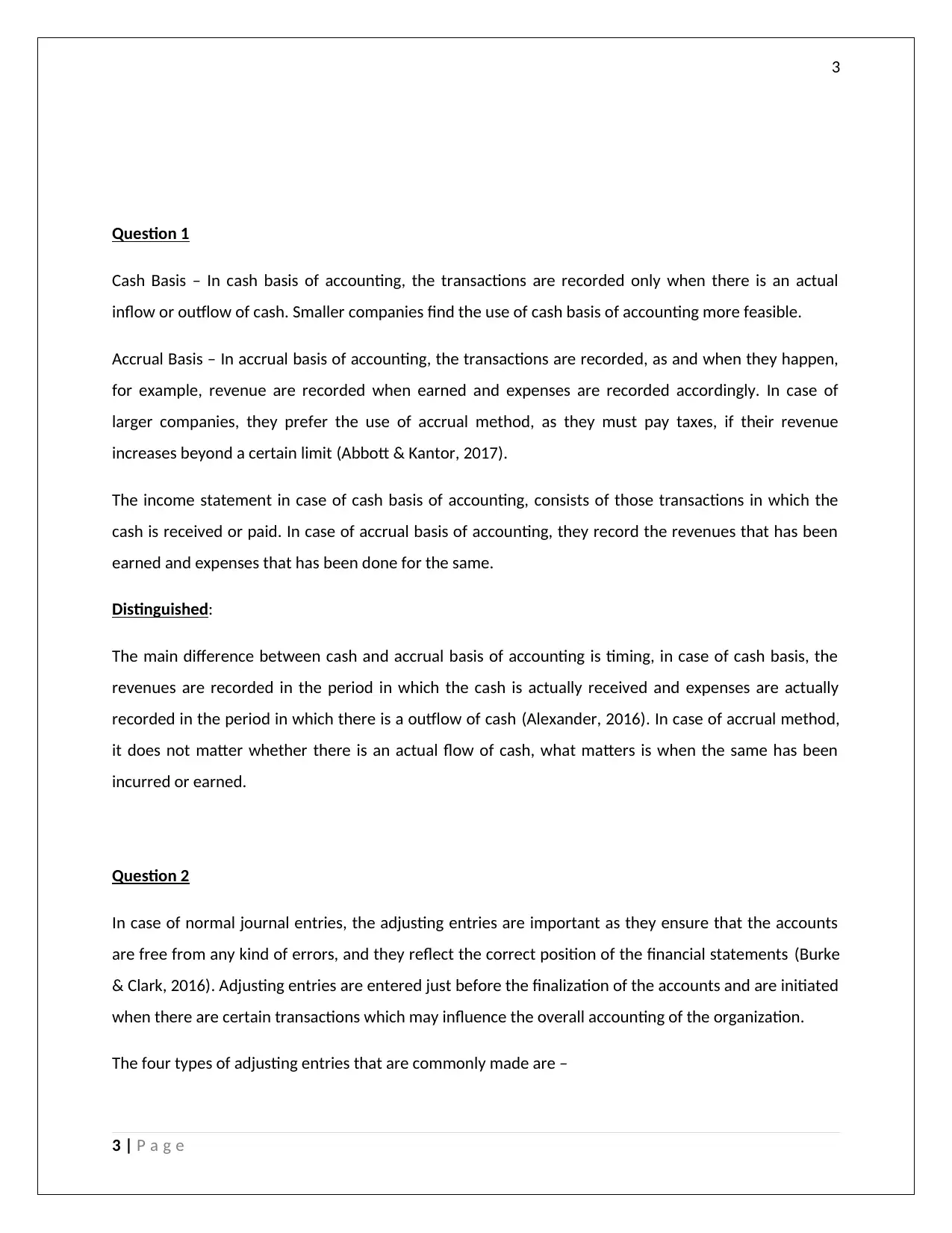
3
Question 1
Cash Basis – In cash basis of accounting, the transactions are recorded only when there is an actual
inflow or outflow of cash. Smaller companies find the use of cash basis of accounting more feasible.
Accrual Basis – In accrual basis of accounting, the transactions are recorded, as and when they happen,
for example, revenue are recorded when earned and expenses are recorded accordingly. In case of
larger companies, they prefer the use of accrual method, as they must pay taxes, if their revenue
increases beyond a certain limit (Abbott & Kantor, 2017).
The income statement in case of cash basis of accounting, consists of those transactions in which the
cash is received or paid. In case of accrual basis of accounting, they record the revenues that has been
earned and expenses that has been done for the same.
Distinguished:
The main difference between cash and accrual basis of accounting is timing, in case of cash basis, the
revenues are recorded in the period in which the cash is actually received and expenses are actually
recorded in the period in which there is a outflow of cash (Alexander, 2016). In case of accrual method,
it does not matter whether there is an actual flow of cash, what matters is when the same has been
incurred or earned.
Question 2
In case of normal journal entries, the adjusting entries are important as they ensure that the accounts
are free from any kind of errors, and they reflect the correct position of the financial statements (Burke
& Clark, 2016). Adjusting entries are entered just before the finalization of the accounts and are initiated
when there are certain transactions which may influence the overall accounting of the organization.
The four types of adjusting entries that are commonly made are –
3 | P a g e
Question 1
Cash Basis – In cash basis of accounting, the transactions are recorded only when there is an actual
inflow or outflow of cash. Smaller companies find the use of cash basis of accounting more feasible.
Accrual Basis – In accrual basis of accounting, the transactions are recorded, as and when they happen,
for example, revenue are recorded when earned and expenses are recorded accordingly. In case of
larger companies, they prefer the use of accrual method, as they must pay taxes, if their revenue
increases beyond a certain limit (Abbott & Kantor, 2017).
The income statement in case of cash basis of accounting, consists of those transactions in which the
cash is received or paid. In case of accrual basis of accounting, they record the revenues that has been
earned and expenses that has been done for the same.
Distinguished:
The main difference between cash and accrual basis of accounting is timing, in case of cash basis, the
revenues are recorded in the period in which the cash is actually received and expenses are actually
recorded in the period in which there is a outflow of cash (Alexander, 2016). In case of accrual method,
it does not matter whether there is an actual flow of cash, what matters is when the same has been
incurred or earned.
Question 2
In case of normal journal entries, the adjusting entries are important as they ensure that the accounts
are free from any kind of errors, and they reflect the correct position of the financial statements (Burke
& Clark, 2016). Adjusting entries are entered just before the finalization of the accounts and are initiated
when there are certain transactions which may influence the overall accounting of the organization.
The four types of adjusting entries that are commonly made are –
3 | P a g e
Paraphrase This Document
Need a fresh take? Get an instant paraphrase of this document with our AI Paraphraser
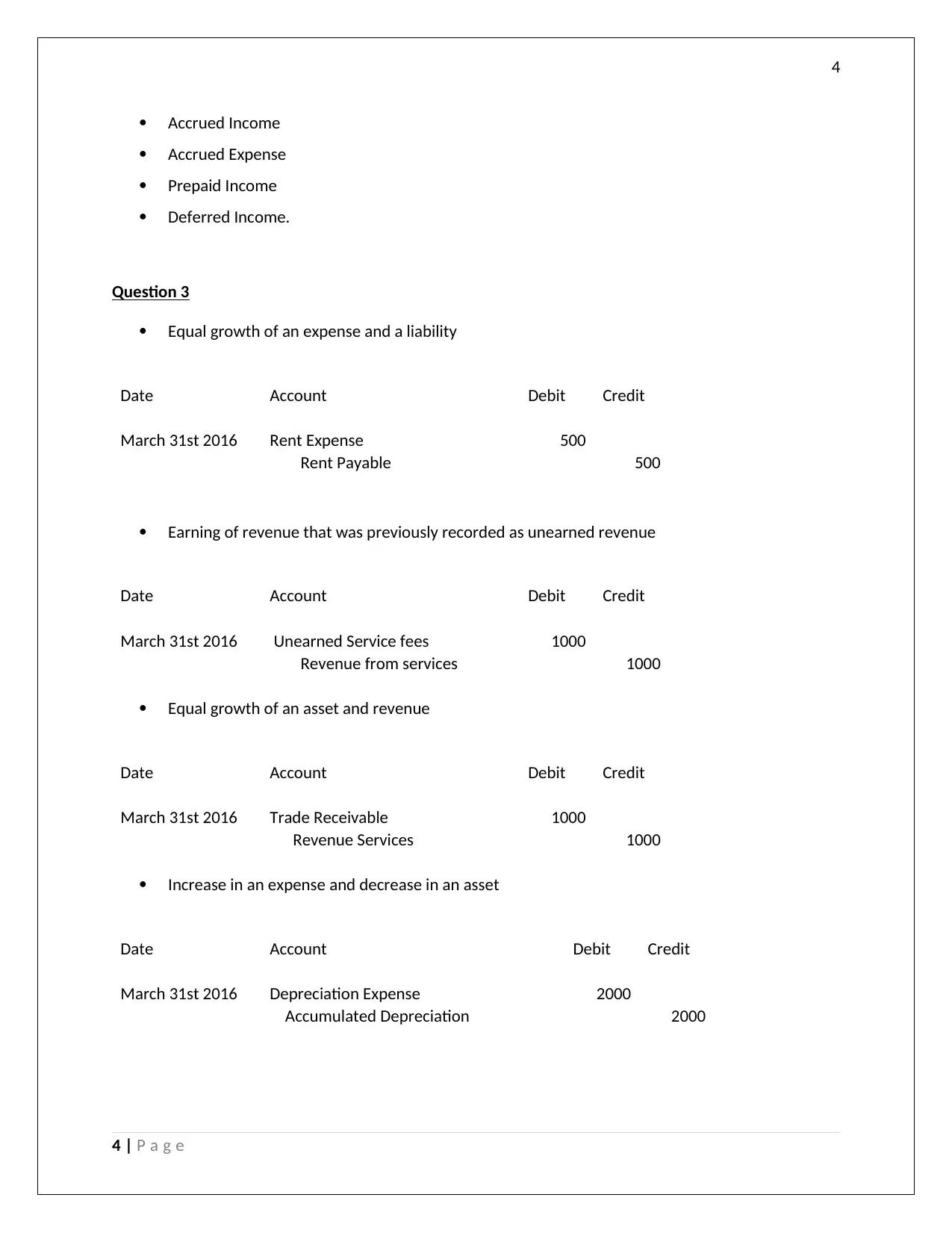
4
Accrued Income
Accrued Expense
Prepaid Income
Deferred Income.
Question 3
Equal growth of an expense and a liability
Date Account Debit Credit
March 31st 2016 Rent Expense 500
Rent Payable 500
Earning of revenue that was previously recorded as unearned revenue
Date Account Debit Credit
March 31st 2016 Unearned Service fees 1000
Revenue from services 1000
Equal growth of an asset and revenue
Date Account Debit Credit
March 31st 2016 Trade Receivable 1000
Revenue Services 1000
Increase in an expense and decrease in an asset
Date Account Debit Credit
March 31st 2016 Depreciation Expense 2000
Accumulated Depreciation 2000
4 | P a g e
Accrued Income
Accrued Expense
Prepaid Income
Deferred Income.
Question 3
Equal growth of an expense and a liability
Date Account Debit Credit
March 31st 2016 Rent Expense 500
Rent Payable 500
Earning of revenue that was previously recorded as unearned revenue
Date Account Debit Credit
March 31st 2016 Unearned Service fees 1000
Revenue from services 1000
Equal growth of an asset and revenue
Date Account Debit Credit
March 31st 2016 Trade Receivable 1000
Revenue Services 1000
Increase in an expense and decrease in an asset
Date Account Debit Credit
March 31st 2016 Depreciation Expense 2000
Accumulated Depreciation 2000
4 | P a g e
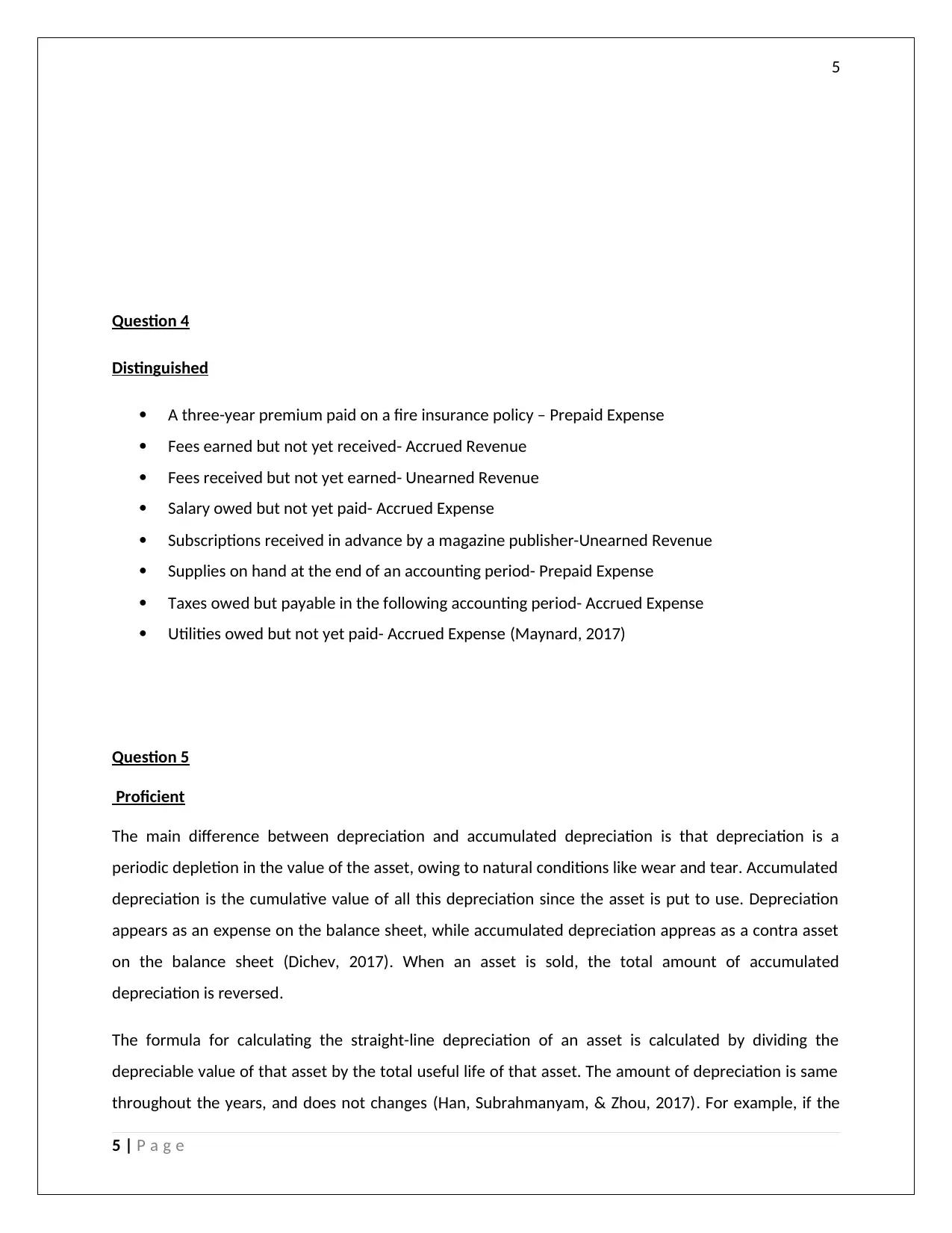
5
Question 4
Distinguished
A three-year premium paid on a fire insurance policy – Prepaid Expense
Fees earned but not yet received- Accrued Revenue
Fees received but not yet earned- Unearned Revenue
Salary owed but not yet paid- Accrued Expense
Subscriptions received in advance by a magazine publisher-Unearned Revenue
Supplies on hand at the end of an accounting period- Prepaid Expense
Taxes owed but payable in the following accounting period- Accrued Expense
Utilities owed but not yet paid- Accrued Expense (Maynard, 2017)
Question 5
Proficient
The main difference between depreciation and accumulated depreciation is that depreciation is a
periodic depletion in the value of the asset, owing to natural conditions like wear and tear. Accumulated
depreciation is the cumulative value of all this depreciation since the asset is put to use. Depreciation
appears as an expense on the balance sheet, while accumulated depreciation appreas as a contra asset
on the balance sheet (Dichev, 2017). When an asset is sold, the total amount of accumulated
depreciation is reversed.
The formula for calculating the straight-line depreciation of an asset is calculated by dividing the
depreciable value of that asset by the total useful life of that asset. The amount of depreciation is same
throughout the years, and does not changes (Han, Subrahmanyam, & Zhou, 2017). For example, if the
5 | P a g e
Question 4
Distinguished
A three-year premium paid on a fire insurance policy – Prepaid Expense
Fees earned but not yet received- Accrued Revenue
Fees received but not yet earned- Unearned Revenue
Salary owed but not yet paid- Accrued Expense
Subscriptions received in advance by a magazine publisher-Unearned Revenue
Supplies on hand at the end of an accounting period- Prepaid Expense
Taxes owed but payable in the following accounting period- Accrued Expense
Utilities owed but not yet paid- Accrued Expense (Maynard, 2017)
Question 5
Proficient
The main difference between depreciation and accumulated depreciation is that depreciation is a
periodic depletion in the value of the asset, owing to natural conditions like wear and tear. Accumulated
depreciation is the cumulative value of all this depreciation since the asset is put to use. Depreciation
appears as an expense on the balance sheet, while accumulated depreciation appreas as a contra asset
on the balance sheet (Dichev, 2017). When an asset is sold, the total amount of accumulated
depreciation is reversed.
The formula for calculating the straight-line depreciation of an asset is calculated by dividing the
depreciable value of that asset by the total useful life of that asset. The amount of depreciation is same
throughout the years, and does not changes (Han, Subrahmanyam, & Zhou, 2017). For example, if the
5 | P a g e
⊘ This is a preview!⊘
Do you want full access?
Subscribe today to unlock all pages.

Trusted by 1+ million students worldwide
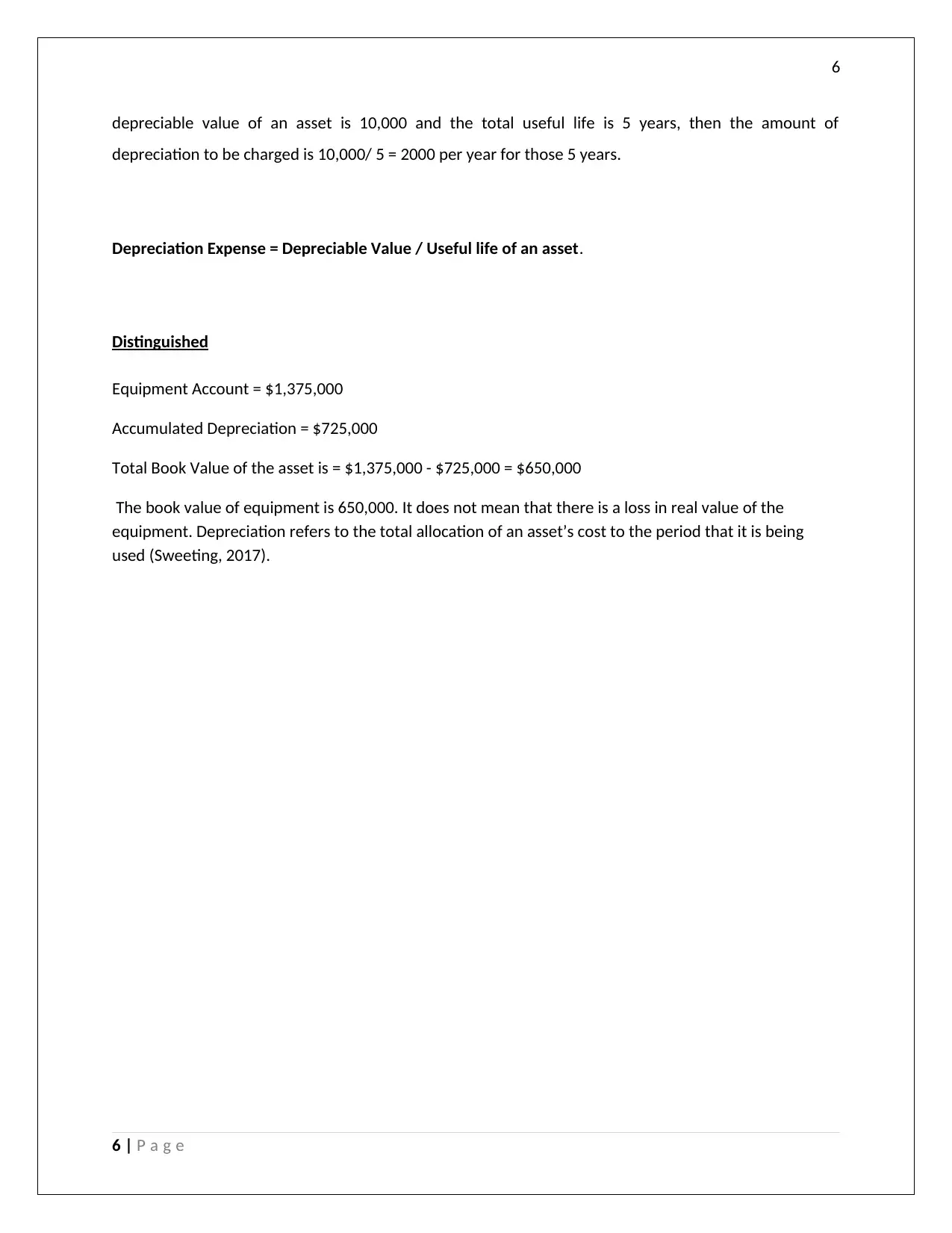
6
depreciable value of an asset is 10,000 and the total useful life is 5 years, then the amount of
depreciation to be charged is 10,000/ 5 = 2000 per year for those 5 years.
Depreciation Expense = Depreciable Value / Useful life of an asset.
Distinguished
Equipment Account = $1,375,000
Accumulated Depreciation = $725,000
Total Book Value of the asset is = $1,375,000 - $725,000 = $650,000
The book value of equipment is 650,000. It does not mean that there is a loss in real value of the
equipment. Depreciation refers to the total allocation of an asset’s cost to the period that it is being
used (Sweeting, 2017).
6 | P a g e
depreciable value of an asset is 10,000 and the total useful life is 5 years, then the amount of
depreciation to be charged is 10,000/ 5 = 2000 per year for those 5 years.
Depreciation Expense = Depreciable Value / Useful life of an asset.
Distinguished
Equipment Account = $1,375,000
Accumulated Depreciation = $725,000
Total Book Value of the asset is = $1,375,000 - $725,000 = $650,000
The book value of equipment is 650,000. It does not mean that there is a loss in real value of the
equipment. Depreciation refers to the total allocation of an asset’s cost to the period that it is being
used (Sweeting, 2017).
6 | P a g e
Paraphrase This Document
Need a fresh take? Get an instant paraphrase of this document with our AI Paraphraser
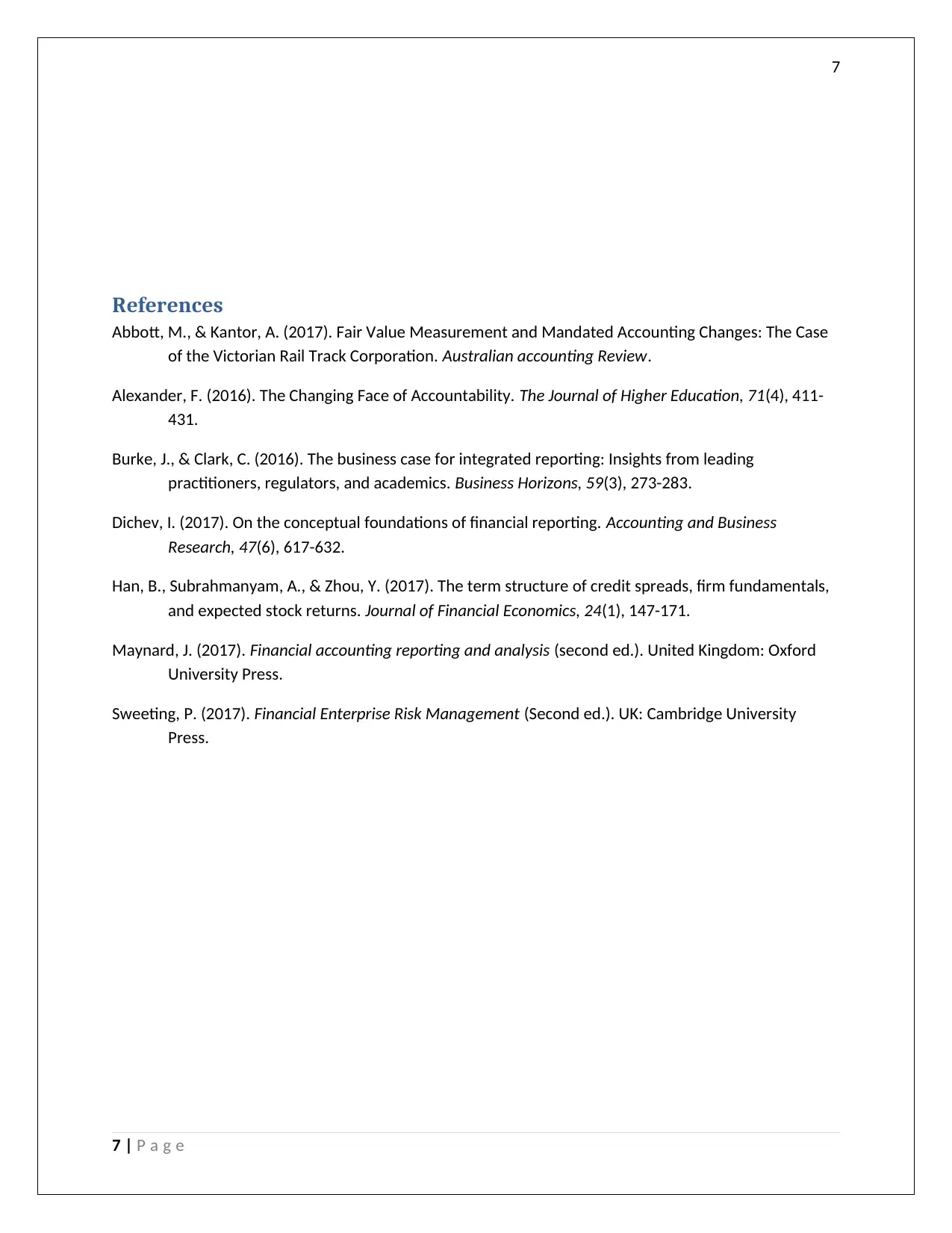
7
References
Abbott, M., & Kantor, A. (2017). Fair Value Measurement and Mandated Accounting Changes: The Case
of the Victorian Rail Track Corporation. Australian accounting Review.
Alexander, F. (2016). The Changing Face of Accountability. The Journal of Higher Education, 71(4), 411-
431.
Burke, J., & Clark, C. (2016). The business case for integrated reporting: Insights from leading
practitioners, regulators, and academics. Business Horizons, 59(3), 273-283.
Dichev, I. (2017). On the conceptual foundations of financial reporting. Accounting and Business
Research, 47(6), 617-632.
Han, B., Subrahmanyam, A., & Zhou, Y. (2017). The term structure of credit spreads, firm fundamentals,
and expected stock returns. Journal of Financial Economics, 24(1), 147-171.
Maynard, J. (2017). Financial accounting reporting and analysis (second ed.). United Kingdom: Oxford
University Press.
Sweeting, P. (2017). Financial Enterprise Risk Management (Second ed.). UK: Cambridge University
Press.
7 | P a g e
References
Abbott, M., & Kantor, A. (2017). Fair Value Measurement and Mandated Accounting Changes: The Case
of the Victorian Rail Track Corporation. Australian accounting Review.
Alexander, F. (2016). The Changing Face of Accountability. The Journal of Higher Education, 71(4), 411-
431.
Burke, J., & Clark, C. (2016). The business case for integrated reporting: Insights from leading
practitioners, regulators, and academics. Business Horizons, 59(3), 273-283.
Dichev, I. (2017). On the conceptual foundations of financial reporting. Accounting and Business
Research, 47(6), 617-632.
Han, B., Subrahmanyam, A., & Zhou, Y. (2017). The term structure of credit spreads, firm fundamentals,
and expected stock returns. Journal of Financial Economics, 24(1), 147-171.
Maynard, J. (2017). Financial accounting reporting and analysis (second ed.). United Kingdom: Oxford
University Press.
Sweeting, P. (2017). Financial Enterprise Risk Management (Second ed.). UK: Cambridge University
Press.
7 | P a g e
1 out of 8
Related Documents
Your All-in-One AI-Powered Toolkit for Academic Success.
+13062052269
info@desklib.com
Available 24*7 on WhatsApp / Email
![[object Object]](/_next/static/media/star-bottom.7253800d.svg)
Unlock your academic potential
Copyright © 2020–2025 A2Z Services. All Rights Reserved. Developed and managed by ZUCOL.





